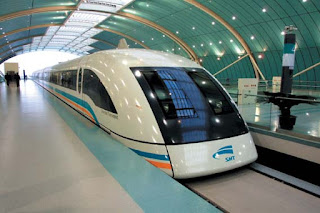Basic Technology Behind Maglev Train
By Shreya Ganguly
Sunday, 5 February 2017
Wednesday, 1 February 2017
Electromagnetic Suspension (EMS)
In electromagnetic
suspension (EMS) systems, the train levitates above a steel rail while electromagnets,
attached to the train, are oriented toward the rail from below. The system is
typically arranged on a series of C-shaped arms, with the upper portion of the
arm attached to the vehicle, and the lower inside edge containing the magnets.
The rail is situated inside the C, between the upper and lower edges.
Magnetic attraction
varies inversely with the cube of distance, so minor changes in distance
between the magnets and the rail produce greatly varying forces. These changes
in force are dynamically unstable – a slight divergence from the optimum
position tends to grow rather, requiring sophisticated feedback systems to
maintain a constant distance from the track, (approximately 15 millimetres
(0.59 in)).
 |
| Photo Courtesy:google.co |
Monday, 30 January 2017
History of Maglev Train:
History of the Maglev Train started in the beginning of the 1900's century with the ideas of American Robert Goddard and the French Emile Bachelet.But both the scientists did not succesed with their ideas.After 60 years the Japanese and the German started doing research on the Maglev Train.
The Japanese started their research in the beginning of the 1970s. After many years of experiments the Japanese constructed their first test line, 7 km in 1975, and they successfully finished in 1977. In 1990 Japan constructed the Yamanashi Maglev test line which became 42.8km long and the first running test was in 1997. The Japanese prototype of maglev train is using repulsive forces to levitate the train, known as electrodynamic suspension, EDS.
The German also started research on maglev train in early 1970s. It took them ten years to complete the construction of the first track model. In 1993 the longest nonstop test running was 1.674 km. That same year the speed record was 450 km/h. In China, 2003, they finished a 30 km long German variant of maglev train in Shanghai, that propels by attractive forces, electromagnetic suspension, EMS . This is the first commercial magnetic levitation train in the world. This project cost over 1 billion dollar.
Working of Maglev Train:
The train will be floating about 10mm above the magnetic guiding track.The train will be propelled to move by the guide way itself. Thus, there is no need of any engine inside the train. The detailed
The train is propelled by the changing in magnetic fields. As soon as the train starts to move, the magnetic field changes sections by switching method and thus the train is again pulled forward.The whole guide way is run by electromagnets so as to provide the magnetic effect.
The two notable types of maglev technology are
·
Electromagnetic suspension
·
Electrodynamic suspension
Wednesday, 11 January 2017
Introduction
Train which driving without wheel and fling without wings.Technically Flying train also called as Maglev Train.Maglev means Magnetic+Levitation which is a transport method where uses magnetic levitation to move vehicles without touching the track.Maglev travels along a guideway using magnet to crate both lift as well as propulsion.
This type of train never touch the ground so reducing friction and allowing higher speed.Maglev Train have recorded speed equal to 581km/hr.Such Technology does not have physical contact between wheel and track.
Subscribe to:
Comments (Atom)



